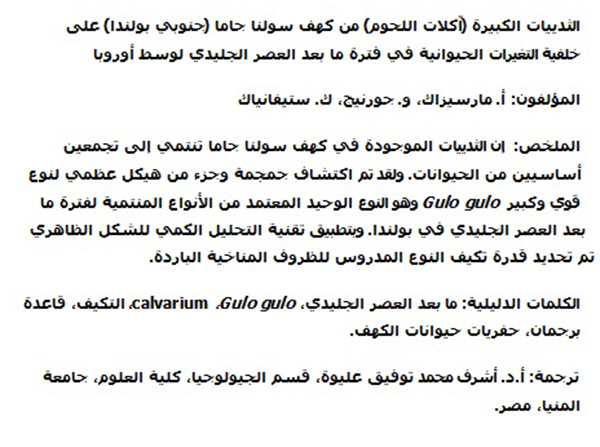Large mammals (carnivores, artiodactyls) from Solna Jama Cave (Bystrzyckie Mts, Southwestern Poland) in the context of faunal changes in the postglacial period of Central Europe
Plain Language Abstract
Solna Jama Cave, small cave situated in an abandoned quarry in Southwestern Poland, before the palaeontological exploration was mostly known for its interesting extant invertebrate fauna. Palaeontological exploration started in the 1980s and resulted in 21 mammal forms found during the excavations. Quite surprisingly, the rodent material is relatively sparse. Shrews and bats are represented by two species, and rodents by five forms. The single find of Capreolus capreolus and undetermined large bovid are the only records of Artiodactyla. Carnivores are the most numerous (10 species) mammal taxon and represent at least four families. Besides the fossil material of mammals some fragments snail shells and undetermined bird fragments were found. Two faunal assemblages have been distinguished. The older one, with Ursus ingressus and single, huge m2 of U. arctos priscus, was dated at ca. 40 Ka. The second assemblage of the postglacial age (ca. 12 Ka) was represented by all the recorded mammal species, excluding the bears. The most noteworthy is a find of a skull and partial skeleton of a very large and robust Gulo gulo, which represents the only reliable Polish record of the species from postglacial period. This assemblage included mammals with different ecological preferences. Species associated with forests, like Sciurus vulgaris, Myodes glareolus, Martes martes, Felis silvestris or Ca. capreolus, have been found, together with those that lived on open habitats like Cricetus cricetus or Mustela eversmanii. Also euryoecious species like Arvicola terrestris, Canis lupus, Vulpes vulpes, G. gulo, Meles meles or Mu. nivalis were found in sediments of Solna Jama Cave. Gulo gulo and Mu. eversmanii are regarded as relict, cold-adapted survivors. The palaeoecological analysis showed the existence of taiga type forests together with small streams and meadows in the environs of the cave. Morphometric characteristics of carnivores, showed some adaptation to cool climatic conditions. Solna Jama Cave was situated on one of the few migration corridors crossing the Carpathian arch (Sudety Mts are the western continuation of the Carpathian Mts). The find expands the knowledge of the Sudetes fauna from the Pleistocene/Holocene boundary. In the future more detail excavations are planned, especially in the newly discovered chimney running from the slope of the hill, probably connected with the cave.
Resumen en Español
Grandes mamíferos (carnívoros, artiodáctilos) de la Cueva Solna Jama (Montes Bystrzyckie, Suroeste de Polonia) en el contexto de los cambios faunísticos durante el período post-glacial de Europa central
Los mamíferos de la Cueva Solna Jama resultaron partes provenientes de dos asociaciones faunísticas principales. La más temprana, datada como MIS 3, incluía algunos huesos de Ursus ingressus y un único m2 del enorme Ursus arctos priscus. La posterior, de edad post-glacial (MIS 1), estaba representada por Canis lupus, Mustela eversmanii y Felis silvestris, entre otros. El hallazgo más impresionante, un cráneo y un esqueleto parcial de un Gulo gulo muy grande y robusto, es el único registro documentado con fiabilidad en Polonia de la especie para el período post-glacial. El hallazgo aumenta el conocimiento de la fauna de los Sudetes para el límite Pleistoceno/Holoceno. Las características morfométricas de los carnívoros, el grupo más numeroso respecto a los otros taxones de mamíferos en esta localidad, mostraron cierta adaptación a las condiciones climáticas frías.
Palabras clave: post-glacial; Gulo gulo; calvarium; adaptación; La regla de Bergmann; fauna fósil cavernícola
Traducción: Enrique Peñalver (Sociedad Española de Paleontología)
Résumé en Français
Les grands mammifères (Carnivores, artiodactyles) de la grotte de Solna Jama (Monts Bystrzyckie, sud-ouest de la Pologne) dans le contexte des changements fauniques de la période post-glaciaire en Europe centrale
Les mammifères de la grotte de Solna Jama faisaient partie de deux principaux assemblages fauniques. Le plus ancien, daté du Stade Isotopique Marin 3, incluait quelques os d'Ursus ingressus et une seule m2 de l'énorme U. arctos priscus. L'assemblage plus récent, d'âge post-glaciaire (Stade Isotopique Marin 1), était représenté, entre autres, par Canis lupus, Mustela eversmanii, et Felis silvestris. La trouvaille la plus impressionnante, une tête osseuse et un squelette partiel d'un spécimen de Gulo gulo très grand et robuste, est le seul signalement fiable de cette espèce en Pologne pour la période post-glaciaire. Cette étude améliore la connaissance de la faune des Sudètes à la limite Pléistocène-Holocène. Les caractéristiques morphométriques des Carnivores, qui sont bien plus abondants que les autres taxons de mammifères dans le site, indiquent des adaptations à des conditions climatiques froides.
Mots-clés : post-glaciaire ; Gulo gulo ; calvarium ; adaptation ; loi de Bergmann ; faune fossile de grotte
Translator: Antoine Souron
Deutsche Zusammenfassung
Große Säugetiere (Karnivoren, Ariodactylen) aus der Solna Jama Höhle (Bystrzyckie Gebirge, südwestliches Polen) im Zusammenhang mit Faunenveränderung während der postglazialen Periode in Zentraleuropa
Säugertiere aus der Solna Jama Höhle sind Teil zwei wichtiger Faunenassemblagen. Die frühere, als MIS 3 datiert, beinhaltete wenige Knochen von Ursus ingressus und einen m2 des großen Ursus arctos priscus. Letzterer, mit einem postglazialen Alter (MIS 1) ist zusammen mit Canis lupus, Mustela eversmanii und Felis silvestris repräsentiert. Der eindrucksvollste Fund, ein Schädel und partielles Skelett eines sehr großen und robusten Gulo gulo, stellt den einzigen sicheren Fund dieser Art aus der postglazialen Periode in Polen dar. Der Fund erweitert das Wissen über die Sudeten-Fauna aus der Pleistozän/Holozän Grenze. Morphometrische Merkmale der Karnivoren, welche die Anzahl der anderen Taxa in dieser Fundstelle bei weitem übertrafen, zeigten einige Anpassungen an kühle klimatische Bedingungen.
Schlüsselwörter: postglazial; Gulo gulo; Schädelkalotte; Adaptation; Bergmannsche Regel; fossile Höhlenfauna
Translator: Eva Gebauer
Arabic

Translator: Ashraf M.T. Elewa

